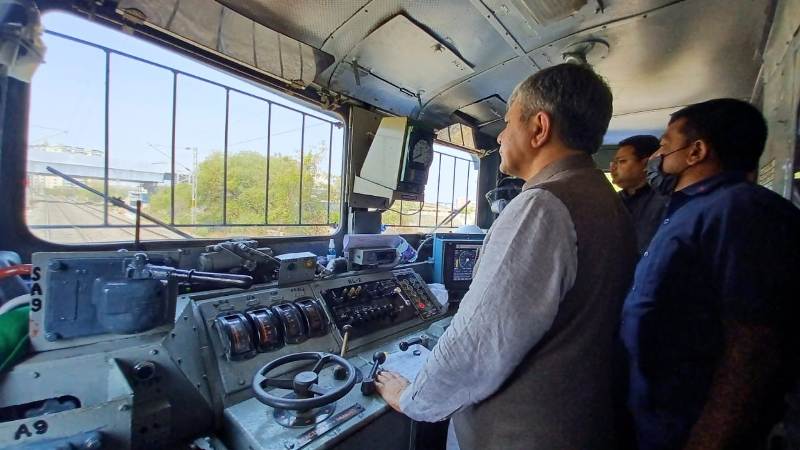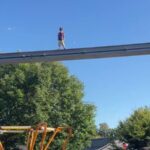A video showed two trains running towards each other at full-speed with Indian Railway Minister on board to test Kavach, a homegrown Automatic Train Protection (ATP) system by Indian Railways. The test was conducted in Secunderabad on Friday. On one train, the Indian Railway Minister Ashwini Vaishnaw was on board. On the other train, it was the chairman of the Railway Board VK Tripathi. The indigenously developed train protection is touted as world’s cheapest automatic train collision protection system that is primarily developed to help Indian railways achieve its ‘zero accidents’ goal. The visuals of the successful test were captured by a drone hovering above the test site. Reportedly, both the trains stopped 380 meters apart, despite being on full speed.
The Facts of the Matter
What is the truest testament of a country trusting its technology?
Is it the fact that the country is willing to share the visuals of the tech testing to the world? Is it the fact that the country is willing to put its ministers on the front-lines to test the tech? Or is it both?
On Friday, the Indian Railway department tested its homegrown Automatic Train Protection system called Kavach. For the unversed, ‘Kavach’ is Hindi means an armour. To test the collision, two trains were made to run towards each other at full-speed. The trains meanwhile carried Indian Railway Minister on one end, and the chairperson of the Railway Board.
The entire test’s visuals were captured by a drone hovering above.
Also Read: Australian Legendary Spinner Shane Warne Passes Away At 52, Cricketing Fraternity Mourns
What Does the Visuals Show?
The two visuals showed two locomotives – one carrying Railway Minister Ashwini Vishnaw and another with board chairman VK Tripathi running towards each other at full speed on the same track. Thanks to the home-grown automatic system in place, the two locomotives stopped about 380 meters apart, and a collision was avoided.
Watch Drone Footage of ‘Kavach’s’ Successful Test
भारत में बना, भारत का कवच!
#BharatKaKavach pic.twitter.com/12vkwgOhS0
— Ministry of Railways (@RailMinIndia) March 4, 2022
Rear-end collision testing is successful.
Kavach automatically stopped the Loco before 380m of other Loco at the front.#BharatKaKavach pic.twitter.com/GNL7DJZL9F— Ashwini Vaishnaw (@AshwiniVaishnaw) March 4, 2022
Loop-line crossing test done👍.
Kavach automatically restricts the speed to 30 kmph (allowed speed) while crossing/entering loop-line. #BharatKaKavach pic.twitter.com/SHDOyaE39u— Ashwini Vaishnaw (@AshwiniVaishnaw) March 4, 2022
How Does Kavach Work?
Kavach works on the basic principle of radio frequency identification. On locomotives, Radio Frequency Identification devices would be set up. The same devices will also be installed on the tracks and the signal systems. These devices will be able to communicate with each other thanks to ultra-high radio frequencies and thus, the brakes of the trains could be pulled during emergencies.
Also Read: Ronit Roy Says he was Paid Less than Junior Artist, Even his Driver Considered It Too Less
Best Features of Home-Grown Train Protection System
One of the most important attributes of this system is the feature through which the train’s movement is continuously refreshed and hence, loco pilots will receive almost real-time triggers. This will be extremely beneficial in situations when a loco pilot jumps a signal, an offence that puts lives at risk, and potentially cause collision like accidents.
Another important feature of the Kavach system is that loco pilots will be able to navigate the train in low visibility because the devices will continually relay signals.
Also Read: Delhi: Woman Convinces Husband to Change Gender, Seeks Divorce After he Changes into “She”
Roll Out So Far and Scheduled Roll Out
It should be noted that Kavach has already been deployed over 1,098 km with 65 locomotives. The Indian Railways has planned an aggressive rollout with the system being implemented across 3,000 km of the Delhi-Mumbai and Delhi-Howrah corridors.
Moreover, Kavach is currently under implementation over 1,200 km of the South-Central\ Railway, Secunderabad-Gadwal-Dhone-Guntakal, Manmad-Parbhani-Nanded sections.
Follow Us on Instagram | Twitter | Facebook | YouTube

























